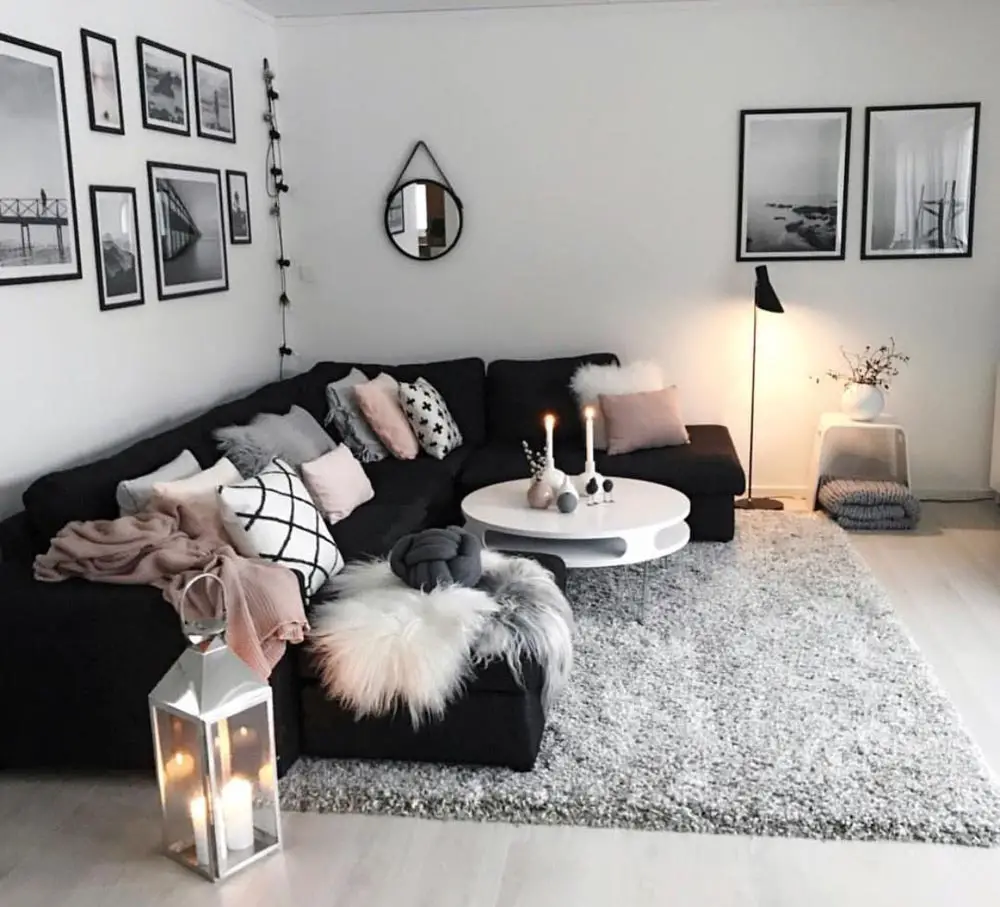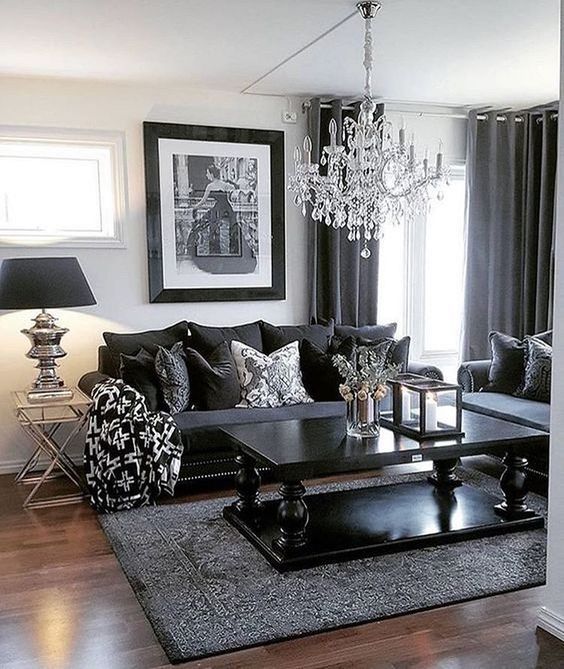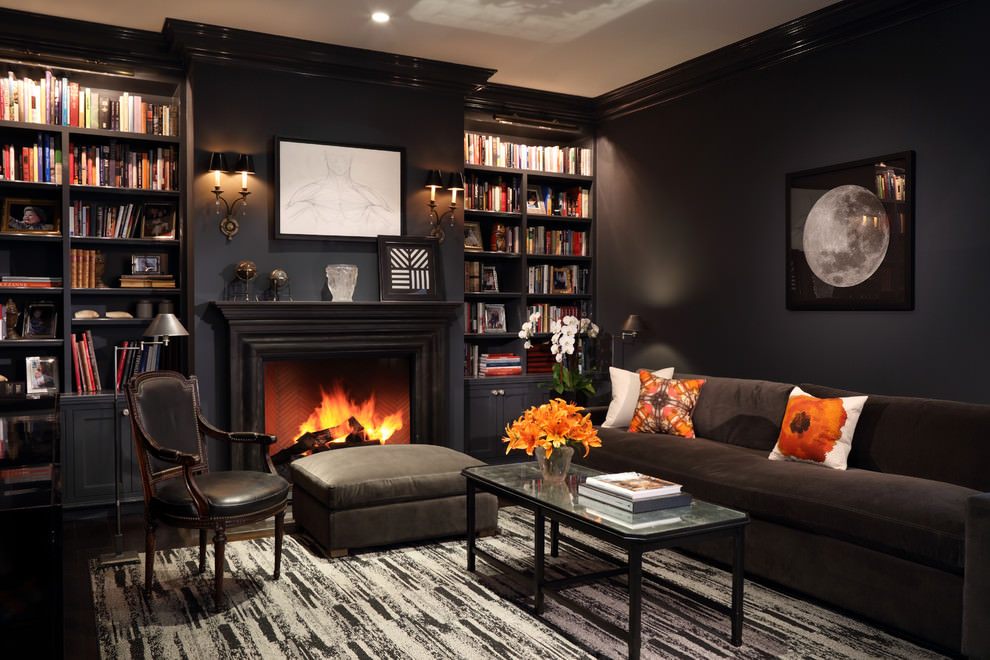Black Magic: Living Room Style
Black Magic: Living Room Style – A Deep Dive into Sophistication and Drama
The allure of black in interior design is undeniable. Often perceived as stark or oppressive, black, when wielded skillfully, transforms a living room into a sanctuary of sophistication, drama, and unexpected warmth. This isn't about a stark, minimalist space; rather, it's about harnessing the power of black to create a rich, layered, and intensely personal atmosphere. This comprehensive guide delves into the art of decorating a black living room, exploring various styles, lighting techniques, material choices, and crucial design principles to ensure your space is both stylish and inviting.
Understanding the Power of Black
Before embarking on the journey of designing a black living room, it’s essential to understand the inherent qualities of the color itself. Black is not merely the absence of light; it's a powerful hue that commands attention, evokes a sense of mystery, and acts as a dynamic backdrop for other colors and textures. It's a color that absorbs light, creating a sense of intimacy and coziness, ideal for creating a dramatic focal point within the room. However, this absorption also requires a careful approach to lighting and the introduction of contrasting elements to avoid a feeling of claustrophobia.
Choosing Your Black: Shades and Variations
The term "black" encompasses a wide spectrum of shades. From deep charcoal grays to near-pure blacks with subtle undertones of blue, green, or even purple, the nuance in your choice dramatically impacts the overall feel of the room.
-
Charcoal Gray: A softer, more approachable alternative to pure black, charcoal gray provides a grounding base while still maintaining a sense of sophistication. It’s ideal for those hesitant to commit fully to black.
-
Jet Black: A true, deep black delivers maximum drama and impact. It’s a powerful choice for creating a truly bold and statement-making space.
-
Black with Undertones: Subtly nuanced blacks, like those with hints of blue or green, can add depth and complexity without sacrificing the dramatic effect. These subtle undertones can be particularly effective in balancing the overall color palette of the room.
Layering Texture and Light: The Key to Success
The key to a successful black living room lies in skillful layering of textures and the strategic placement of lighting. Black, while beautiful, can easily feel flat without the right textural contrast.
Texture is paramount:
-
Velvet Upholstery: Luxurious velvet sofas and armchairs add a touch of opulence and warmth, breaking up the visual monotony of black. The plush texture is visually appealing and provides a comforting tactile experience.
-
Rattan and Woven Accents: Incorporating natural materials like rattan or woven baskets adds a layer of visual warmth and contrast to the sleekness of the black. These elements bring a sense of organic texture and visual interest.
-
Rugged Textiles: Think sheepskin throws, chunky knit blankets, or a richly textured area rug. These add warmth, tactility, and visual depth, preventing the space from feeling cold or sterile.
-
Metallic Accents: Brass, gold, or copper finishes on furniture legs, lighting fixtures, or decorative objects can add a touch of glamour and reflect light to counteract the light-absorbing nature of black.
Lighting is crucial:

-
Ambient Lighting: A combination of overhead lighting (recessed or a statement chandelier) and floor lamps provides even illumination, preventing dark corners and shadows.
-
Accent Lighting: Task lighting (reading lamps, desk lamps) and accent lighting (picture lights, spotlights) highlight specific features and add depth to the space.
-
Natural Light: Maximize the use of natural light by keeping window treatments minimal. Sheer curtains or blinds allow light to filter through while still maintaining privacy.

- Layered Lighting: Avoid relying on a single light source. Layering different types of lighting – ambient, task, and accent – creates a dynamic and inviting atmosphere.
Incorporating Color: The Art of Contrast
While black forms the foundation, incorporating pops of color is vital to prevent the living room from becoming too heavy or overwhelming. Consider these strategies:

-
Complementary Colors: Introduce pops of vibrant colors that complement black, such as bright orange, sunny yellow, or crisp white. These additions provide contrast and energy.
-
Analogous Colors: Consider using shades adjacent to black on the color wheel, like deep greens, blues, or grays. These create a harmonious and sophisticated palette.
-
Accent Walls: A single accent wall in a contrasting color can dramatically alter the perception of the space. This can be a great technique to visually balance the dark tones.

- Statement Art: Bold artwork in contrasting colors can become a striking focal point within the black backdrop, drawing the eye and adding a burst of personality.
Different Styles for a Black Living Room
The versatility of black allows it to be incorporated into various design styles:

-
Modern Minimalist: A black living room with minimalist furniture and clean lines creates a sleek and sophisticated space. This style emphasizes functionality and clean lines.
-
Glamorous Hollywood: Velvet furniture, metallic accents, and crystal chandeliers bring a touch of old-Hollywood glamour to a black living room. This style is all about opulence and luxury.
-
Industrial Chic: Black metal furniture, exposed brick, and Edison-style bulbs create an edgy and industrial-inspired living room. This style balances sophistication with raw industrial elements.

- Bohemian Black: Pairing black furniture with richly textured rugs, vibrant textiles, and eclectic accessories creates a bohemian black living room that’s both dramatic and inviting. This is a style that embraces a mix of textures and colors.
Choosing the Right Furniture: Form and Function
Furniture choices are paramount in a black living room. Consider the following:

-
Scale and Proportion: Avoid overcrowding the space with too much furniture. Choose pieces that are appropriately scaled to the room's size to prevent it from feeling cramped.
-
Material Choices: Mix and match materials – leather, velvet, wood, metal – to add visual interest and prevent monotony.
-
Statement Pieces: Incorporate one or two statement pieces, such as a unique sofa or a striking coffee table, to anchor the room and provide a focal point.

Accessorizing Your Black Living Room: Adding Personality
Accessories are the finishing touches that personalize your black living room:
- Plants: Introduce greenery to add life and freshness to the space. Black acts as a stunning backdrop for lush plants.

-
Artwork: Choose artwork that complements the overall aesthetic and adds a personal touch. Consider abstract art, photography, or even bold graphic prints.
-
Throw Pillows and Blankets: Textured throws and cushions add comfort and visual interest, creating a warmer, more inviting atmosphere.
Conclusion: Embracing the Dark Side

Designing a black living room is an exciting journey that allows for creativity and personalization. By carefully considering the nuances of black, layering textures, strategically employing lighting, and incorporating contrasting elements, you can create a space that is both dramatic and incredibly inviting. Remember, the goal is not to create a dark and oppressive space but a sanctuary of style, sophistication, and unexpected warmth. A well-designed black living room stands as a testament to the power of design and the transformative capabilities of a seemingly simple color. Embrace the dark side – you might be surprised at the beautiful results.
Black Living Room: Dark & Dramatic
The allure of a black living room is undeniable. It's a bold statement, a sophisticated departure from the predictable, and a design choice that offers a unique opportunity for both drama and intimacy. While some might shy away from such a daring color palette, embracing the darkness can reveal a surprisingly versatile and luxurious space. This exploration delves into the nuances of designing a black living room, covering everything from choosing the right shade of black to incorporating complementary textures, lighting, and furniture.
The Psychology of Black
Before diving into the practical aspects of design, let's consider the psychology behind choosing black for your living room. Black is often associated with power, sophistication, and mystery. It's a color that commands attention, creating a feeling of depth and intrigue. However, it's also crucial to understand that black can feel overwhelming if not used thoughtfully. The key lies in balancing the darkness with lighter elements and strategic textural contrasts. A poorly executed black living room can feel claustrophobic and oppressive, while a well-designed one exudes a captivating and modern elegance. The aim is to harness the power of black without sacrificing comfort and livability.
Choosing the Right Shade of Black
Not all blacks are created equal. The subtle variations in undertones can significantly impact the overall mood and feel of your living room. Consider these options:
-
Deep Black: This is the truest, most intense black, offering maximum drama and sophistication. It's ideal for creating a truly dramatic atmosphere but requires careful consideration of lighting to avoid a cave-like effect.
-
Charcoal Black: A slightly softer black with gray undertones. Charcoal black provides a more relaxed and less intense feel than deep black, making it a suitable choice for those who want the elegance of black without the overwhelming darkness.
-
Black with a Hint of Blue or Green: These subtle undertones can add depth and warmth to the black, preventing it from feeling too harsh or cold. The specific undertone will influence the overall mood—blue can create a cooler, more sophisticated feel, while green can introduce a touch of earthiness.
Selecting the right shade requires considering the natural light in your living room. A north-facing room with limited natural light might benefit from a slightly warmer black, while a south-facing room with abundant sunlight can handle a deeper, more intense shade. Test paint samples in your room at different times of day to see how the light affects the color.
Balancing Light and Dark
The most crucial element in a successful black living room is lighting. Without adequate lighting, the space can feel suffocating and gloomy. Layering lighting is essential:
-
Ambient Lighting: This provides overall illumination and sets the mood. Recessed lighting, chandeliers (consider a dramatic black chandelier!), or strategically placed floor lamps can serve this purpose.
-
Task Lighting: This provides focused light for specific activities, such as reading or working. Table lamps, desk lamps, and even strategically placed wall sconces can offer focused illumination.
-
Accent Lighting: This enhances specific features or artwork. Track lighting, spotlights, or even fairy lights can add sparkle and draw attention to focal points.
Consider using warm-toned lighting (e.g., incandescent or warm LED bulbs) to counteract the coldness that black can sometimes project. Avoid harsh, cool-toned lighting, which can make the black appear even harsher.
Texture and Material: The Key to Depth
Texture plays a vital role in preventing a black living room from feeling flat and monotonous. Incorporating a variety of textures adds visual interest and depth:
-
Velvet: This luxurious fabric adds a touch of opulence and softens the starkness of black. Consider velvet sofas, armchairs, or throw pillows.
-
Leather: Leather adds a touch of rugged masculinity and sophistication. Leather sofas, armchairs, or ottomans can be stunning in a black living room.

-
Wood: The warmth and natural grain of wood provide a beautiful contrast to the black. Consider wooden coffee tables, side tables, or shelving units.
-
Metal: Metal accents, such as brass or chrome, can add a touch of glamour and shine. Consider metal lamps, picture frames, or decorative objects.
-
Rugs: A large, textured rug can anchor the space and add warmth underfoot. Consider a rug with a bold pattern or a plush, high-pile texture.

Incorporating Color
While black is the dominant color, it doesn't have to be the only color. Strategic use of other colors can enhance the drama and create visual interest:
- Gold Accents: Gold adds a touch of glamour and luxury, creating a striking contrast against the black.

-
White or Cream Accents: These lighter colors provide a necessary contrast, preventing the room from feeling too heavy. Consider white or cream throw pillows, curtains, or artwork.
-
Metallic Accents: Other metallic accents such as copper or silver can also work well, depending on the overall style you're aiming for.
-
Pops of Color: Introduce small pops of vibrant color through artwork, decorative objects, or plants to add personality and prevent monotony. However, keep these pops of color small and strategic to avoid overwhelming the overall black aesthetic.

Furniture Selection
Choosing the right furniture is critical in creating a balanced and inviting black living room. Consider the following:
- Statement Pieces: Incorporate one or two statement pieces—a dramatic black sofa, an eye-catching armchair, or a unique coffee table—to draw the eye and create a focal point.

-
Scale and Proportion: Pay attention to the scale and proportion of your furniture. Overly large furniture can make the room feel cramped, while overly small furniture can get lost in the space.
-
Functionality: Choose furniture that is both stylish and functional. Consider storage solutions to keep the space clutter-free.
Artwork and Accessories

Artwork and accessories can elevate a black living room from stylish to truly exceptional. Consider:
-
Large-Scale Artwork: A large piece of artwork can serve as a focal point and add visual interest.
-
Mirrors: Strategically placed mirrors can reflect light and make the room feel larger and brighter.

-
Plants: Introduce greenery to add life and freshness to the space, counteracting the darkness of the black walls and furniture. Choose plants that thrive in low-light conditions.
-
Sculptures and Decorative Objects: These can add personality and visual interest. Choose pieces that complement the overall style of the room.
Different Styles in a Black Living Room

The beauty of a black living room is its versatility. It can adapt to numerous styles:
-
Modern Minimalist: Clean lines, simple furniture, and minimal accessories create a sleek and sophisticated look.
-
Mid-Century Modern: Incorporate iconic mid-century modern furniture pieces and warm wood tones for a retro-chic vibe.

-
Glamorous Hollywood Regency: Embrace opulent fabrics, metallic accents, and dramatic lighting for a glamorous and luxurious feel.
-
Gothic Victorian: Incorporate dark woods, rich textures, and antique furniture for a moody and atmospheric space.
Conclusion

Designing a black living room is an adventurous undertaking that rewards those willing to embrace the darkness. By carefully considering lighting, texture, color accents, and furniture selection, you can create a space that is both dramatic and inviting, luxurious and livable. Remember, the key is balance. Embrace the power of black, but always ensure that it's balanced with light, texture, and carefully chosen complementary elements. The result will be a living room that is truly unique and unforgettable.

